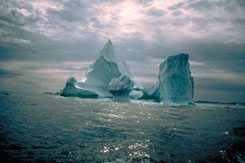The North Atlantic is not only dangerous, but also highly variable. In a state of nearly continuous flux, the region experiences changes on several different
time-scales: winds suddenly increase within a few minutes as a frontal system passes by; longer, warmer days finally release the area from winter's icy grip; icebergs push further south after a string of successive cold years. All of these changes
occur within relatively short units of time, but changes occur over much longer time scales as well. This slide set explores Heinrich events: climate fluctuations in the North Atlantic over the last 60,000 years.
Photo Credits:
Anne Jennings
Institute of Arctic and Alpine Research, University of Colorado-Boulder Boulder, Colorado

Download a zip file
of a full resolution TIF image
